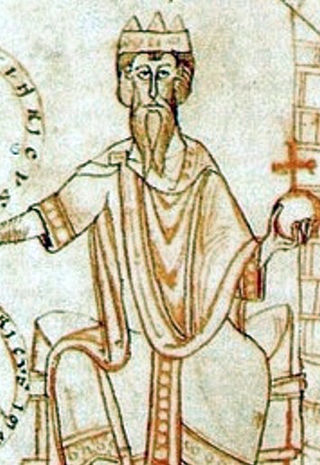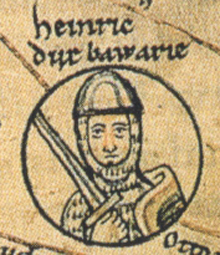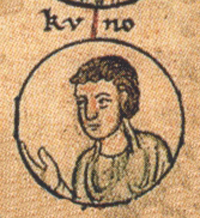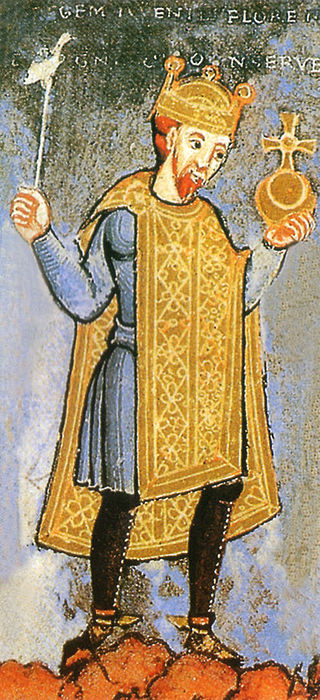
The Salian dynasty or Salic dynasty was a dynasty in the High Middle Ages. The dynasty provided four kings of Germany (1024–1125), all of whom went on to be crowned Holy Roman emperors (1027–1125).

Otto II, called the Red, was Holy Roman Emperor from 973 until his death in 983. A member of the Ottonian dynasty, Otto II was the youngest and sole surviving son of Otto the Great and Adelaide of Italy.

Conrad II, also known as Conrad the Elder and Conrad the Salic, was the emperor of the Holy Roman Empire from 1027 until his death in 1039. The first of a succession of four Salian emperors, who reigned for one century until 1125, Conrad ruled the kingdoms of Germany, Italy and Burgundy.

Lotharingia was a medieval successor kingdom of the Carolingian Empire. It comprised present-day Lorraine (France), Luxembourg, Saarland (Germany), Netherlands, most of Belgium, and Germany west of the Rhine. It was named after King Lothair II, who received this territory as his share of the Kingdom of Middle Francia which his father, Lothair I, had held.

Lothair, sometimes called Lothair II, III or IV, was the penultimate Carolingian king of West Francia, reigning from 10 September 954 until his death in 986.

The County of Bar, later Duchy of Bar, was a principality of the Holy Roman Empire encompassing the pays de Barrois and centred on the city of Bar-le-Duc. It was held by the House of Montbéliard from the 11th century. Part of the county, the so-called Barrois mouvant, became a fief of the Kingdom of France in 1301 and was elevated to a duchy in 1354. The Barrois non-mouvant remained a part of the Empire. From 1480, it was united to the imperial Duchy of Lorraine.

Leopold I, known as the Illustrious was a member of the House of Babenberg who ruled as Margrave of Austria from 976 until his death. He was the first margrave of the Babenberg dynasty which ruled the March and Duchy of Austria until its extinction in 1246.

Godfrey I, called the Bearded, the Courageous, or the Great, was the Landgrave of Brabant, Count of Brussels and Leuven (Louvain) from 1095 to his death and Duke of Lower Lorraine from 1106 to 1129. He was also Margrave of Antwerp from 1106 to his death.

Godfrey III, called the Bearded, was the eldest son of Gothelo I, Duke of Upper and Lower Lorraine.

Henry I, a member of the German royal Ottonian dynasty, was Duke of Bavaria from 948 until his death.
Otto II, a member of the Ezzonid dynasty, was Count Palatine of Lotharingia from 1034 until 1045 and Duke of Swabia from 1045 until his death.
Otto III, called the White and known as Otto of Schweinfurt, was the margrave of the Nordgau (1024–1031) and duke of Swabia (1048–1057). He was the son of Henry of Schweinfurt, margrave of the Nordgau, and Gerberga of Henneberg. Otto was one of the most powerful East Franconian princes by inheritance: having extensive land in the Radenzgau and Schweinfurt. In 1014, he first appears as count of Lower Altmühl and, in 1024, he inherits his father's march. In 1034, Otto became count of the Lower Naab. From then on to his appointment to Swabia, he takes part in many imperial expeditions into Bohemia, Hungary, and Poland. He was betrothed to Matilda, daughter of Bolesław I the Brave, but the arrangement fell through.
Herman I was the first Conradine Duke of Swabia, the son of Gebhard, Duke of Lorraine, and a cousin of King Conrad I of Germany.

Conrad I, a member of the Salian dynasty, was Duke of Carinthia from 1004 until his death.

The Duchy of Franconia was one of the five stem duchies of East Francia and the medieval Kingdom of Germany emerging in the early 10th century. The word Franconia, first used in a Latin charter of 1053, was applied like the words Francia, France, and Franken, to a portion of the land occupied by the Franks.
The House of Ardenne–Verdun was a branch of the House of Ardenne, one of the first documented medieval European noble families, centered on Verdun. The family dominated in the Duchy of Lotharingia (Lorraine) in the 10th and 11th centuries. All members descended from Cunigunda of France, a granddaughter of the West Frankish king Louis the Stammerer. She married twice but all or most of her children were children of her first husband, Count Palatine Wigeric of Lotharingia. The other main branches of the House of Ardennes were the House of Ardenne–Luxembourg, and the House of Ardenne–Bar.
The Conradines or Conradiner were a dynasty of Franconian counts and dukes in the 8th to 11th Century, named after Duke Conrad the Elder and his son King Conrad I of Germany.

Otto I, traditionally known as Otto the Great, or Otto of Saxony, was East Frankish king from 936 and Holy Roman Emperor from 962 until his death in 973. He was the eldest son of Henry the Fowler and Matilda of Ringelheim.

Henry III, called the Black or the Pious, was Holy Roman Emperor from 1046 until his death in 1056. A member of the Salian dynasty, he was the eldest son of Conrad II and Gisela of Swabia.

Henry II, also known as Saint Henry, Obl. S. B., was Holy Roman Emperor from 1014. He died without an heir in 1024, and was the last ruler of the Ottonian line. As Duke of Bavaria, appointed in 995, Henry became King of the Romans following the sudden death of his second cousin, Emperor Otto III in 1002, was made King of Italy in 1004, and crowned emperor by Pope Benedict VIII in 1014.